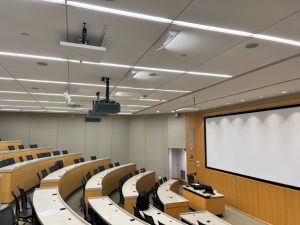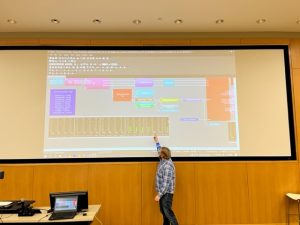 The use of technology in the classroom is becoming increasingly prevalent in today’s educational landscape. As schools and universities adopt new and innovative solutions to enhance the learning experience for students, one area of focus has been improving the quality of audio in the classroom. The DDMC recently sat down with Steven Pretzer, an AV support tech at Fuqua School of Business, to discuss the installation of three new microphone arrays in the McClendon and HCA classrooms. In this article, we will explore the benefits of microphone arrays over traditional tabletop microphones, the challenges of implementing them in a classroom setting, and best practices for their use.
The use of technology in the classroom is becoming increasingly prevalent in today’s educational landscape. As schools and universities adopt new and innovative solutions to enhance the learning experience for students, one area of focus has been improving the quality of audio in the classroom. The DDMC recently sat down with Steven Pretzer, an AV support tech at Fuqua School of Business, to discuss the installation of three new microphone arrays in the McClendon and HCA classrooms. In this article, we will explore the benefits of microphone arrays over traditional tabletop microphones, the challenges of implementing them in a classroom setting, and best practices for their use.
- What is a microphone array, and how does it differ from traditional table microphones?
A microphone array is a microphone system that uses multiple microphones arranged in a specific pattern to capture audio in challenging acoustic environments. It uses beamforming technology to enhance sound coming from specific directions while reducing unwanted background noise and reverberation. The microphones are combined to create a virtual microphone that can be aimed and steered to capture audio from a particular area. It is often used in situations where multiple speakers are present, such as in a panel discussion or a classroom lecture and can provide high-quality audio for remote participants in video conferencing systems.
A microphone array differs from a tabletop microphone in several ways. First, a microphone array is typically mounted on the ceiling or wall and can capture audio from multiple directions simultaneously, while a tabletop microphone only captures audio from a single direction. This allows microphone arrays to pick up a wider range of sounds and voices in a classroom setting, improving the overall quality of audio.
- What are the benefits of using microphone arrays in a classroom setting?
Using microphone arrays instead of tabletop microphones in a classroom setting offers several benefits, including the ability to capture sound from a wider area, reducing background noise and reverberation, being more discreet, and being more cost-effective in the long run. This enhances the learning experience for students and teachers alike by providing clear and intelligible audio in a range of challenging acoustic environments.
- How do microphone arrays improve the quality of audio in a classroom environment?
Microphone arrays improve the quality of audio in a classroom environment by providing clear and intelligible audio that can be easily understood by students and teachers. This is achieved through a combination of features, including the ability to capture sound from a wider area, reducing background noise and reverberation, and the ability to steer and focus the audio in real-time towards the person speaking. In contrast, traditional tabletop microphones can often be garbled and difficult to distinguish between speakers, particularly in larger classrooms or lecture halls. By using microphone arrays, the need for additional equipment, such as lavaliere microphones, can also be reduced, resulting in a simpler and more streamlined audio setup that is easier to manage and maintain. Overall, the use of microphone arrays can significantly enhance the quality of audio in a classroom environment, improving the learning experience for students and teachers alike.
- What are some of the challenges associated with implementing microphone arrays in a classroom, and how can they be addressed?
Implementing microphone arrays in a classroom can present several challenges that need to be addressed to ensure optimal performance. One of the main challenges is the complex acoustic environment of a classroom, which can include a variety of sound sources, such as students talking, moving around, and rustling papers. In addition, the shape and size of the classroom, as well as the placement of the microphones, can also affect the quality of the audio captured.
To address these challenges, it is important to carefully plan the installation and setup of the microphone array system. This may involve using specialized software to analyze the acoustic environment and optimize the placement and configuration of the microphones. It may also involve walking the room and testing the system to ensure that it is capturing clear and intelligible audio from all areas of the classroom.
- What factors should be considered when selecting a microphone array for a classroom setting?
Installation type and location, backend interface. All play into the choice.
When selecting a microphone array for a classroom, factors such as installation type and location, backend interface, size and shape of the room, number of students and teachers, and the acoustic environment of the room should be considered. Ceiling-mounted microphones may offer wider coverage and be more discreet, while wall-mounted microphones can provide better directionality and control. The interface should be compatible with the existing audio system and any additional equipment that may be needed. Advanced noise reduction capabilities may be necessary for classrooms with high levels of ambient noise. By carefully considering the specific needs of the classroom and the capabilities of different microphone array systems, schools and universities can select a system that provides clear and intelligible audio for students and teachers.
- How do microphone arrays improve the learning experience for students and teachers?
Clarity, Clarity, Clarity!
Microphone arrays can greatly enhance the learning experience for both students and teachers in the classroom. They improve the clarity of audio, reduce the need for repeating questions, and help the classroom flow more smoothly. Microphone arrays can create a more inclusive learning environment, making it easier for all students to hear and understand what is being said. This is particularly beneficial for students with hearing impairments or those who may struggle to hear in a crowded or noisy classroom. Overall, microphone arrays can greatly enhance the learning experience in the classroom by improving audio quality and creating a more inclusive environment.
- Why use ceiling mounted microphone arrays in a classroom?
Ceiling-mounted microphone arrays can offer superior audio quality compared to other types of microphones, thanks to their advanced beamforming technology. This technology allows the microphones to focus on the speaker and filter out unwanted background noise, resulting in clear and intelligible audio for all students. While other types of microphones, such as wall-mounted or portable microphone arrays, may be suitable for certain classrooms, ceiling-mounted microphone arrays offer several key advantages that make them a superior solution for most classroom environments. By providing wide coverage, reducing disruptions, and delivering high-quality audio, ceiling-mounted microphone arrays can greatly enhance the learning experience for both students and teachers.
- What are some best practices for using microphone arrays in a classroom setting?
A In line ducker in the DSP. Gain Structure. Focused on speech. High Pass filters. NOM limit of 1 with the ceiling arrays to keep the noise floor low and a lower hold time on the gating auto mixer to ease the transition between open mics.
If something you’re doing is not making it better? Don’t do it!
To optimize the use of microphone arrays in a classroom setting, there are some best practices that should be followed. Firstly, it is important to use an in-line ducker in the DSP, which will automatically lower the volume ofany background noise when someone is speaking. This can greatly improve the overall audio quality and intelligibility.
Secondly, attention should be paid to gain structure, ensuring that the microphones are set at the appropriate level to capture speech without picking up unwanted noise. Additionally, the microphones should be focused on speech, with any background noise or reverberation minimized using high-pass filters.
Finally, it is important to remember that if a certain adjustment or change is not making the audio quality better, it is better not to do it. This can prevent unnecessary tinkering and ensure that the microphone arrays are being used in the most effective and efficient way possible. By following these best practices, the use of microphone arrays in a classroom setting can be optimized, resulting in improved audio quality and a more effective learning environment.
Additionally, the advanced beamforming technology of microphone arrays allows them to filter out unwanted background noise, resulting in clear and intelligible audio.
When selecting a microphone array for a classroom setting, factors such as installation type, location, and backend interface should be considered. Ceiling-mounted microphone arrays are often a superior solution, thanks to their wider coverage and advanced beamforming technology, but other types of microphones may be suitable for certain classrooms.
To optimize the use of microphone arrays in a classroom setting, best practices such as using an in-line ducker in the DSP, paying attention to gain structure, and minimizing background noise using high-pass filters should be followed. By following these best practices, the use of microphone arrays can be optimized, resulting in improved audio quality and a more effective learning environment.
The use of microphone arrays in a classroom setting can greatly enhance the learning experience for both students and teachers. By providing wider coverage, reducing disruptions, and delivering high-quality audio, microphone arrays can ensure that everyone in the classroom can be heard clearly without the need for passing microphones around.
Meet Steven Pretzer

A skilled audio engineer and AV support tech at Fuqua School of Business. With a degree in Recording Industry Production and Technology and a minor in Mass Communication, Steven’s passion for audio began at an early age. After working as a freelance audio engineer in Nashville for several years, Steven moved to Chapel Hill in 2008 where he focused on playing bass in several bands and continued to do independent recordings from his home studio.
In 2017, Steven became a contractor at Fuqua through Duke temporary services and in 2019, he was hired in the position of AV support tech at Fuqua. As an AV support tech, Steven’s primary job is to support faculty, staff, and students regarding classroom technology. Utilizing his background in audio engineering, Steven has been able to focus on and improve communication in Fuqua classrooms.
In addition to his experience, Steven has received several Biamp certifications including Tesira Forte and Tesira Servers as well as Dante level 1. With his expertise in audio and classroom technology, Steven has been able to implement microphone arrays in Fuqua classrooms, greatly enhancing the learning experience for both students and teachers.

Here at University of Rochester, we are also a big fan of the Biamp Tesira Forte and the Array Microphones. They have worked miraclees in our smaller classrooms 25-30 seats.